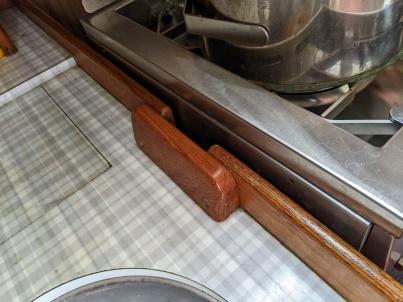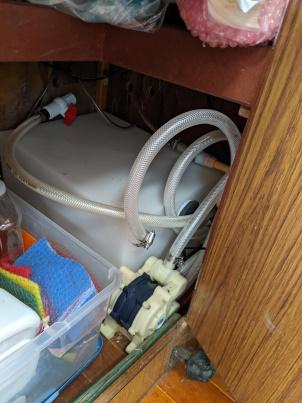Welcome Back › Forums › Other › Cruising Comfort › Galley Ideas
- This topic has 0 replies, 1 voice, and was last updated 2 years, 6 months ago by
 Moderator.
Moderator.
-
AuthorPosts
-
August 3, 2022 at 21:55 #27247
 ModeratorKeymaster
ModeratorKeymasterIdeas for the galley.
1. A salt water foot pump in the galley for e.g. rinsing dirty dishes before washing sparingly with fresh water. This allows us to conserve precious fresh water, yet still feel the dishes are getting clean! We converted the foot pump to fresh water for a while, but we are changing it back to salt water because we miss being able to flush as much water as we want.
For the saltwater, we use a Whale Gusher Galley foot pump to a dedicated spigot. The hose run from the seacock to foot pump should be a short as possible to avoid stagnant seawater from going sulfurous. We formerly had it connected to the aft head inlet seacock in the bilge (aft head removed by PO), but this run through the engine room was too long. We’re thinking of adding a new 1/2″ seacock under the cooker to have a very short run. We hope to insert a means to drain the line after the seacock is closed, again to avoid that horrid stagnant sulfurous seawater when the foot pump is not used regularly.
2. Better insulation for the original ice box. We have lined the interior of the box with foam sheet insulation, carefully covered in Formica to protect it and sealed all sides and corners with aluminum tape. This is not enough. Our Rainshadow has blue topsides, and when the sun hits the port side even on a modest heat day, the topside can be too hot to touch! We tried to add more insulation behind the ice box, but the space is limited and access is hard (and requires disassembling the forward cupboard to gain access-which reminds me, while that cupboard is disassembled, make the time to pull and inspect the aft lower shroud chainplate that is buried behind that cupboard too.) We even go so far that, when the sun is heating the port topsides, we hang from the stanchions a weighted sheet of reflective foil bubble wrap-type insulation to prevent direct sunlight hitting the topsides outboard of the ice box. I’m not sure what the best solution for this ice box problem is, except to say better insulation is required – and a lighter colored topsides is a great idea.
3. When looking to replace the original cooker, realize that the fore-aft dimension between the sink cabinet and the forward bulkhead is not consistent along its height. I measured the gap at the bottom, decided our chosen replacement would just fit, only to discover that separation at the top is less than the separation at the bottom, so to fit the gimbals we had to modify the sink cabinet fiddles. ugh!

The replacement we picked is the Dickinson Marine Caribbean, which has tremendous heating capabilities in comparison to the original cooker. It also has a very nicely insulated oven for baking bread. Avid bakers will want to custom cut a porcelain tile to use as a baking stone.

4. The wooden bar in front of the cooker shown above is another safety-at-sea feature. It stops a person from being thrown against the stove, and gives something to hold on to. It’s held in place with stout closet rod holders, and some custom shaping of the bar ends because the bar angles from the sink base to forward bulkhead.
5. We now sail in warm climates so decided hot running water was not needed, meaning we need only one tap in the galley. We installed a wall-mounted pot filler type faucet, which has a double joint swing arm for extending and shortening the position of the tap. Wall-mounted faucets free up much needed counter space around the sink basin and make for easier cleanup.

6. Add an inline water filter between the potable water tank and the tap. Given that we typically trust our incoming water supply, we use the Omnipure K5522-BB that has a 5 micron filter, and has carbon filtration to remove the chlorine taste created when we treat the tank water with bleach. We also sometimes keep a Brita filter pitcher strapped in the galley area for removing worse contaminants from just drinking water.
7. It’s too easy for the fresh water tank or system to become contaminated with something foul. On our passage, our tap water began to taste of mildew due to cross contamination between the seldom used hot tap and the cold tap. We were very glad we had the means to get drinking water directly from our water maker before it ran into the main water tank. Unfortunately the only way to do this was brace near the watermaker and fill jugs. To make passage life easier we have since added a couple gallon “day water tank” in the galley sink cabinet (outboard) that is filled by the watermaker, and then “overflows” to the main fresh water tank if we choose to run the watermaker long enough to top up the main water tank as well. The day tank has its own hand-pump tap, keeping it separate from the pressurized system and all its failure points. We left the plumbing hoses long enough that we can remove the tank from its tight location for cleaning.

-
AuthorPosts
- You must be logged in to reply to this topic.